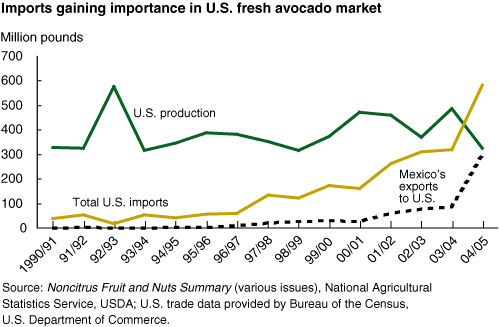New Phytosanitary Regulations Allow Higher Imports of Avocados
- by Agnes Perez and Donna Roberts
- 11/1/2006
Phytosanitary measures restrict or regulate imported food products to combat the entry and establishment of foreign pests and diseases. Import bans are sometimes used to reduce phytosanitary risks, but such measures can restrict the seasonal availability of a product or significantly raise costs for consumers. Advances in scientific risk assessment methods over the past decade have helped regulators design less trade-restrictive measures for some products, such as avocados, that reduce phytosanitary risks while allowing imports.
USDA initially banned imports of Mexican avocados in 1914 to prevent entry of avocado seed weevils into the United States. USDA’s Animal and Plant Health Inspection Service (APHIS) partially lifted this ban in 1993 when it allowed Mexican avocados to be shipped to Alaska under the terms of an import protocol that stipulated production and shipping requirements. Since then, APHIS has revised the import protocol three times, gradually lifting geographical and seasonal restrictions. By 2005, Mexico had year-round market access to all States except California, Florida, and Hawaii, and it will gain access to those States in 2007. Safeguards—such as annual field surveys and packinghouse requirements—against the entry of avocado pests remain mandatory. These measures increase exporter production costs, but enable market access. Avocado imports from Mexico rose from just over 1 million pounds in 1993/94 to 296 million pounds in 2004/05, about half the total U.S. import volume.
The key to changes in U.S. import policy for Mexican avocados has been the adoption of a systems approach to risk management, consisting of a number of sequential safeguards designed to progressively reduce risk to an insignificant level. If one mitigating measure fails, the other safeguards are in place to ensure the reduction of pest or disease risks. The net benefits of these more targeted approaches to reduce pest and disease risks can be estimated under alternative scenarios.
The annual net benefits of lifting the geographical and seasonal restrictions, while maintaining the other phytosanitary safeguards that are currently required, were found to total about $70 million. If these safeguards were removed, the expected pest-related costs would exceed the savings in compliance costs under most scenarios, reducing estimated economic gains. These estimates provide analytic support for the decision by APHIS to replace the ban on imported Mexican avocados with a more targeted systems approach.
This article is drawn from:
- Illustration of the Modeling Framework: Economic Effects of the U.S. Ban on Avocados from Mexico. (1999). USDA, Economic Research Service. in A Framework for Analyzing Technical Trade Barriers in Agricultural Markets, TB-1876. .



